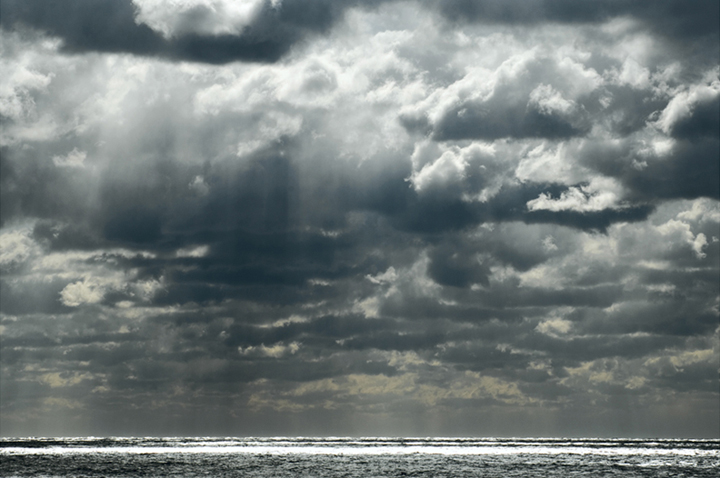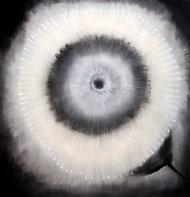The New York Times
Sunday, September 25, 2011
Invitation to an Exhibition: Let the Mentoring Begin
By MARTHA SCHWENDENER
Courtesy of Renate Aller
SELECTIONS A print from Renate Aller’s “Oceanscapes” series, from “Artists Choose Artists” at the Parrish Art Museum.
Juried exhibitions, in which the works have been selected from a pool of submissions, used to be more common, although artists have long expressed conflicted feelings about them. They are one of the best ways for little-known artists to get their work shown in major museums or galleries, yet charges of favoritism and nepotism have dogged juried exhibitions for centuries.
“Artists Choose Artists,” the second such show at the Parrish Art Museum in Southampton, tweaks the model: works by the exhibition’s seven East End jurors appear alongside those of the local artists they selected; each juror has chosen two artists out of more than 200 submissions.
A photograph at the entrance shows participating artists (minus a few) lined up casually against a wall, engaged in what seem to be collegial conversations. (Or, perhaps, conversations staged for the camera.) A similar type of communication, arranged for the gallery, occurs among the artworks. Within each grouping, one can see certain threads and themes emerge.
One of the jurists, Alice Aycock, is a sculptor who works on a monumental scale, creating objects and installations that draw on modern architecture and explore systems and cosmologies. Ms. Aycock is represented in the exhibition by a little aluminum sculpture — little by her standards — called “Twist of Fate,” from 2011, whose elements mimic the turns and shifts of destiny. One of the artists she has chosen, Kryn Olson, paints moody, visceral canvases that offer possible explanations for how we see and experience the world. “Dream House,” from 2010, is a deep red canvas with a scrawled house that looks almost like a rocket taking off. Mike Solomon, Ms. Aycock’s other choice, is represented by “GO,” from 2005, a sculpture made of net, fiberglass and resin that looks like a wave curling out from the wall.
Courtesy of Ross Bleckner
Ross Bleckner’s “Separated by a Curtain.”
The artists chosen by Ross Bleckner, a painter known for canvases that hover between abstraction and representation, display an ethereal quality similar to his own, except in photographs rather than paint. Mr. Bleckner’s “Separated by a Curtain,” from 2010, is a large canvas with fuzzy concentric circles reminiscent of an iris and pupil. The three images from Renate Aller’s series “Oceanscapes — One View: 1999 to Present,” from 2009, are similarly spectral and evocative, with swirling masses of clouds dwarfing the slivers of sea at the bottom of the photographs.
Like Mr. Bleckner, Gary Simmons, another juror, employs smearing effects in the outlined objects in his elegantly minimal paintings. (At one time, he worked on chalkboards.) His work has often used blurring and erasure as a metaphor for the social treatment of certain racial and ethnic groups. (Mr. Simmons, who is of African descent, was born in Barbados.)
Perry Burns and Melinda Hackett, Mr. Simmons’s choices for the exhibition, follow some of these strands. Mr. Burns’s collage-paintings are made from photographs of protesters — the titles, “Bolsheviks” and “Revolution #10,” both from 2011, give you an idea — that disintegrate into pixelated grids at the bottom of the frame. Ms. Hackett’s paintings are exuberant, decorative fields. All they would need is one good swipe with a squeegee to look like Mr. Simmons’s “You, Me, Him & Her,” from 2008, a canvas with arabesque shapes drawn in white outline and blurred onto a deep blue ground.
Occasionally, the jurors’ selections run distinctly against the grain. For instance, the naïve, garish paintings of Nella Khanis would probably end up at the bottom of many jurors’ lists, but they made the cut with Agathe Snow, the youngest juror in the pool at 35, who is a noted denizen of downtown New York. (She was married to the artist Dash Snow, although they had divorced by the time he died of a drug overdose in 2009.) This makes sense, though, since paintings like Ms. Khanis’s bright still life “Bite Me!” from 1993, which features a multicolored fish on a platter, look perfectly at home alongside Ms. Snow’s 2011 mobile with papier-mâché divers and a shark, hanging from curtain rods and suspended from the ceiling; its title is “there’s always a first time for everything.”
Ms. Snow’s other selection, Alice Hope, seems a little tamer — although Ms. Hope’s Web site thanks “supporters” like the apparently fictional Institute of Aesthetics = Magnetism and WD-40 XXX. Ms. Hope’s “Shifting,” from 2011, is a wall smothered in chains and ferrite magnets.
The exhibition leans heavily toward painting and sculpture, although Matthew Satz, a maker of hybrid works that incorporate materials like tar, feathers and smoke, made a leap by choosing Liliya Lifanova. Ms. Lifanova is a fairly young artist (she is 28), and her extremely stylish and well-produced videos recall upscale science-fiction movies and the films of Matthew Barney, but they don’t seem to be saying much of anything. Mr. Satz’s other choice, Terry Elkins, offers a painting that could serve as a pendant piece to Ms. Aller’s “Oceanscapes” photographs: a long triptych with a wave creeping toward the viewer, titled “Atlantic Beach,” from 1995.
Two other artists, Dan Rizzie and Frank Wimberley, made selections that complement their fairly traditional painting practices. Mr. Rizzie’s simple black-and-white panels, featuring “5 Barns/Black,” from 1979, are answered copacetically by Ross Watts’s and Tad Wiley’s geometric works, also on wood.
Mr. Wimberley’s “Watchtower for a Clock Stopp’d,” from 2002, is a deeply textured, mostly black-and-white painting with a coarse surface. Julie Small-Gamby also explores texture and surface with canvases that include T-shirts attached and painted onto them, while Fulvio Massi’s works are covered with masses of marks and doodles that suggest, but never resolve themselves into, leaves and eyes and other objects.
A museum statement accompanying “Artists Choose Artists” said the exhibition was designed to “encourage engagement and mentorship among local artists.” One wonders, with some of these pairings, if this will really be the case. Will Ms. Snow and Ms. Khanis begin hobnobbing or exchanging studio visits? It seems unlikely. Similarly, it’s hard to imagine Mr. Massi, a seasoned, exhibiting painter, taking tips from Mr. Wimberley (although Mr. Wimberley, at 85, is nearly 30 years his senior).
More likely, the relationships forged in the process of the show, which included visits by jurists to the studios of those they selected, will follow the model of the photograph hung at the entrance: a few conversations will develop; some artists will make an effort to encourage and mentor. But for the sake of this exhibition, the conversations that really matter are the ones that take place on the wall.
“Artists Choose Artists” is at the Parrish Art Museum, 25 Jobs Lane, Southampton, through Oct. 9. Information: (631) 283-2118; parrishart.org.
A version of this review appeared in print on September 25, 2011, on page LI6 of the New York edition with the headline: Invitation to an Exhibition: Let the Mentoring Begin.

